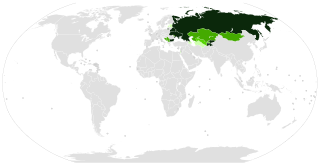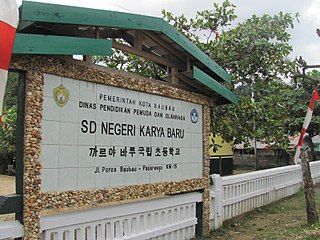
An alphabet is a standardized set of basic written symbols or graphemes that represent the phonemes of certain spoken languages. Not all writing systems represent language in this way; in a syllabary, each character represents a syllable, for instance, and logographic systems use characters to represent words, morphemes, or other semantic units.

Fingerspelling is the representation of the letters of a writing system, and sometimes numeral systems, using only the hands. These manual alphabets, have often been used in deaf education, and have subsequently been adopted as a distinct part of a number of sign languages; there are about forty manual alphabets around the world. Historically, manual alphabets have had a number of additional applications—including use as ciphers, as mnemonics, and in silent religious settings.

Korean is an East Asian language spoken by about 77 million people. It is the official and national language of both Koreas: North Korea and South Korea, with different standardized official forms used in each country. It is a recognised minority language in the Yanbian Korean Autonomous Prefecture and Changbai Korean Autonomous County of Jilin Province, China. It is also spoken in parts of Sakhalin, Russia and Central Asia.

The Latin alphabet or Roman alphabet is the collection of letters originally used by the ancient Romans to write the Latin language and its extensions used to write modern languages.

Writing is a medium of human communication that involves the representation of a language with symbols. Writing systems are not themselves human languages ; they are means of rendering a language into a form that can be reconstructed by other humans separated by time and/or space. While not all languages utilize a writing system, those with systems of inscriptions can complement and extend capacities of spoken language by enabling the creation of durable forms of speech that can be transmitted across space and stored over time. It has also been observed that the activity of writing itself can have knowledge-transforming effects, since it allows humans to externalize their thinking in forms that are easier to reflect on and potentially rework. Writing relies on many of the same semantic structures as the speech it represents, such as lexicon and syntax, with the added dependency of a system of symbols to represent that language's phonology and morphology. The result of the activity of writing is called a text, and the interpreter or activator of this text is called a reader.
A breve is the diacritic mark ˘, shaped like the bottom half of a circle. As used in Ancient Greek, it is also called brachy, βραχύ. It resembles the caron but is rounded, in contrast to the angular tip of the caron.

Romanization or romanisation, in linguistics, is the conversion of writing from a different writing system to the Roman (Latin) script, or a system for doing so. Methods of romanization include transliteration, for representing written text, and transcription, for representing the spoken word, and combinations of both. Transcription methods can be subdivided into phonemic transcription, which records the phonemes or units of semantic meaning in speech, and more strict phonetic transcription, which records speech sounds with precision.

Yery, Yeru, Ery or Eru, usually called Ы [ɨ] in modern Russian or еры yerý historically and in modern Church Slavonic, is a letter in the Cyrillic script. It represents the close central unrounded vowel after non-palatalised (hard) consonants in the Belarusian and Russian alphabets.
Several manual alphabets in use around the world employ two hands to represent some or all of the letters of an alphabet, usually as a part of a deaf sign language. Two-handed alphabets are less widespread than one-handed manual alphabets. They may be used to represent the Latin alphabet or the Cyrillic alphabet.
The history of alphabetic writing goes back to the consonantal writing system used for Semitic languages in the Levant in the 2nd millennium BCE. Most or nearly all alphabetic scripts used throughout the world today ultimately go back to this Semitic proto-alphabet. Its first origins can be traced back to a Proto-Sinaitic script developed in Ancient Egypt to represent the language of Semitic-speaking workers and slaves in Egypt. Unskilled in the complex hieroglyphic system used to write the Egyptian language, which required a large number of pictograms, they selected a small number of those commonly seen in their Egyptian surroundings to describe the sounds, as opposed to the semantic values, of their own Canaanite language. This script was partly influenced by the older Egyptian hieratic, a cursive script related to Egyptian hieroglyphs.

In a featural writing system, the shapes of the symbols are not arbitrary but encode phonological features of the phonemes that they represent. The term featural was introduced by Geoffrey Sampson to describe the Korean alphabet and Pitman shorthand.
Korean Sign Language or KSL is the Deaf sign language of South Korea. It is often referred to simply as 수화; 手話; suhwa, which means signing in general.
The Serbian Cyrillic alphabet is an adaptation of the Cyrillic script for the Serbian language, developed in 1818 by Serbian linguist Vuk Karadžić. It is one of the two alphabets used to write standard modern Serbian, Bosnian and Montenegrin varieties of Serbo-Croatian language, the other being Latin.

Numerous Cyrillic alphabets are based on the Cyrillic script. The early Cyrillic alphabet was developed in the First Bulgarian Empire during the 9th century AD at the Preslav Literary School by Saint Clement of Ohrid and Saint Naum and replaced the earlier Glagolitic script developed by the Byzantine theologians Cyril and Methodius. It is the basis of alphabets used in various languages, past and present, in parts of Southeastern Europe and Northern Eurasia, especially those of Slavic origin, and non-Slavic languages influenced by Russian. As of 2011, around 252 million people in Eurasia use it as the official alphabet for their national languages. About half of them are in Russia. Cyrillic is one of the most-used writing systems in the world.

A writing system is a method of visually representing verbal communication, based on a script and a set of rules regulating its use. While both writing and speech are useful in conveying messages, writing differs in also being a reliable form of information storage and transfer. Writing systems require shared understanding between writers and readers of the meaning behind the sets of characters that make up a script. Writing is usually recorded onto a durable medium, such as paper or electronic storage, although non-durable methods may also be used, such as writing on a computer display, on a blackboard, in sand, or by skywriting. Reading a text can be accomplished purely in the mind as an internal process, or expressed orally.

Cia-Cia, also known as Buton or Butonese, is an Austronesian language spoken principally around the city of Baubau on the southern tip of Buton Island off the southeast coast of Sulawesi in Indonesia.
There are three schools for the deaf in Burma, the Mary Chapman School for the Deaf in Yangon, the School for the Deaf, Mandalay, and the Immanuel School for the Deaf in Kalay. However, oral Burmese is the language of instruction, at least in Yangon, with sign used to support it. The sign language used in Yangon and Mandalay is different, but it's not clear if they are one language or two. Influences on the language(s) include ASL in all schools, as well as Korean Sign Language, Australian Sign Language, Thai Sign Language, and possibly a local substratum. A government project was set up in 2010 to establish a national sign language with the aid of the Japanese Federation of the Deaf.

The Korean alphabet, known as Hangul (Hangeul) in South Korea and Chosŏn'gŭl in North Korea, is a writing system for the Korean language created by King Sejong the Great in 1443. The letters for the five basic consonants reflect the shape of the speech organs used to pronounce them, and they are systematically modified to indicate phonetic features; similarly, the vowel letters are systematically modified for related sounds, making Hangul a featural writing system.











































